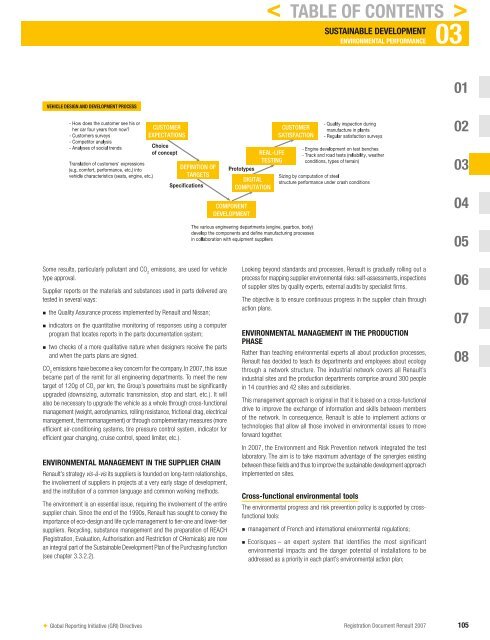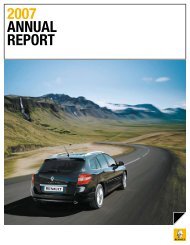2007 Interactive Registration Document - Renault
2007 Interactive Registration Document - Renault
2007 Interactive Registration Document - Renault
You also want an ePaper? Increase the reach of your titles
YUMPU automatically turns print PDFs into web optimized ePapers that Google loves.
VEHICLE DESIGN AND DEVELOPMENT PROCESS<br />
Some results, particularly pollutant and CO 2 emissions, are used for vehicle<br />
type approval.<br />
Supplier reports on the materials and substances used in parts delivered are<br />
tested in several ways:<br />
n<br />
n<br />
n<br />
the Quality Assurance process implemented by <strong>Renault</strong> and Nissan;<br />
indicators on the quantitative monitoring of responses using a computer<br />
program that locates reports in the parts documentation system;<br />
two checks of a more qualitative nature when designers receive the parts<br />
and when the parts plans are signed.<br />
CO 2 emissions have become a key concern for the company. In <strong>2007</strong>, this issue<br />
became part of the remit for all engineering departments. To meet the new<br />
target of 120g of CO 2 per km, the Group’s powertrains must be signifi cantly<br />
upgraded (downsizing, automatic transmission, stop and start, etc.). It will<br />
also be necessary to upgrade the vehicle as a whole through cross-functional<br />
management (weight, aerodynamics, rolling resistance, frictional drag, electrical<br />
management, thermomanagement) or through complementary measures (more<br />
effi cient air-conditioning systems, tire pressure control system, indicator for<br />
effi cient gear changing, cruise control, speed limiter, etc.).<br />
ENVIRONMENTAL MANAGEMENT IN THE SUPPLIER CHAIN<br />
<strong>Renault</strong>’s strategy vis-à-vis its suppliers is founded on long-term relationships,<br />
the involvement of suppliers in projects at a very early stage of development,<br />
and the institution of a common language and common working methods.<br />
The environment is an essential issue, requiring the involvement of the entire<br />
supplier chain. Since the end of the 1990s, <strong>Renault</strong> has sought to convey the<br />
importance of eco-design and life cycle management to tier-one and lower-tier<br />
suppliers. Recycling, substance management and the preparation of REACH<br />
(<strong>Registration</strong>, Evaluation, Authorisation and Restriction of CHemicals) are now<br />
an integral part of the Sustainable Development Plan of the Purchasing function<br />
(see c hapter 3.3.2.2).<br />
✦ Global Reporting Initiative (GRI) Directives<br />
SUSTAINABLE DEVELOPMENT 03<br />
ENVIRONMENTAL PERFORMANCE<br />
Looking beyond standards and processes, <strong>Renault</strong> is gradually rolling out a<br />
process for mapping supplier environmental risks: self-assessments, inspections<br />
of supplier sites by quality experts, external audits by specialist fi rms.<br />
The objective is to ensure continuous progress in the supplier chain through<br />
action plans.<br />
ENVIRONMENTAL MANAGEMENT IN THE PRODUCTION<br />
PHASE<br />
Rather than teaching environmental experts all about production processes,<br />
<strong>Renault</strong> has decided to teach its departments and employees about ecology<br />
through a network structure. The industrial network covers all <strong>Renault</strong>’s<br />
industrial sites and the production departments comprise around 300 people<br />
in 14 countries and 42 sites and subsidiaries.<br />
This management approach is original in that it is based on a cross-functional<br />
drive to improve the exchange of information and skills between members<br />
of the network. In consequence, <strong>Renault</strong> is able to implement actions or<br />
technologies that allow all those involved in environmental issues to move<br />
forward together.<br />
In <strong>2007</strong>, the Environment and Risk Prevention network integrated the test<br />
laboratory. The aim is to take maximum advantage of the synergies existing<br />
between these fi elds and thus to improve the sustainable development approach<br />
implemented on sites.<br />
Cross-functional environmental tools<br />
The environmental progress and risk prevention policy is supported by crossfunctional<br />
tools:<br />
n<br />
n<br />
< TABLE OF CONTENTS ><br />
management of French and international environmental regulations;<br />
Ecorisques – an expert system that identifies the most significant<br />
environmental impacts and the danger potential of installations to be<br />
addressed as a priority in each plant’s environmental action plan;<br />
01<br />
02<br />
03<br />
04<br />
05<br />
06<br />
07<br />
08<br />
<strong>Registration</strong> <strong>Document</strong> <strong>Renault</strong> <strong>2007</strong> 105




